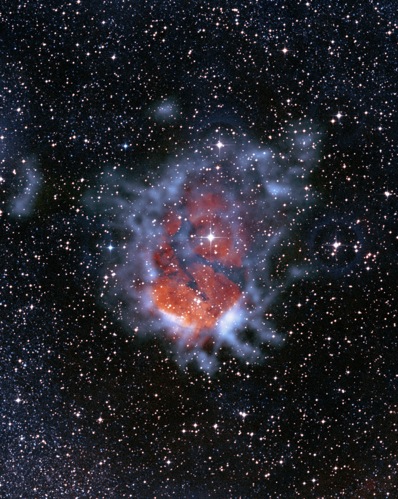By using sub-millimetre wavelength astronomy, astronomers have revealed the cold dense clouds of material that are the birth places of new stars.
Astronomers using the LABOCA camera on the 12 metre Atacama Pathfinder Experiment (APEX) telescope detected clumps of cold gas four times fainter than ever seen before, and which had been forced to collapse as an expanding bubble of ionised gas about ten light years across swept through the region known as RCW120.

Colour composite image of RCW120. The submillimetre emission is shown as the blue clouds surrounding the reddish glow of the ionised gas. Image: ESO/APEX/DSS2/ SuperCosmos.
RCW120 is located some 4,200 light years from Earth towards the constellation of Scorpius and hosts a hot, massive star in its centre. The star is emitting huge amounts of ultraviolet radiation, which ionises the surrounding gas, stripping the electrons from hydrogen atoms and producing the characteristic red glow of so-called H-alpha emission.
Accompanying the ionised region is a shock wave, which sweeps up a layer of the surrounding cold interstellar gas and cosmic dust. This layer becomes unstable and collapses under its own gravity into dense clumps, forming cold, dense clouds of hydrogen where new stars are born. Since the clouds are still extremely cold at just -250 degrees Celsius, their faint heat glow can only be seen at sub-millimetre wavelengths, demonstrating the importance of sub-millimetre astronomy in studying the earliest stages of stellar life. Moreover, since the brightness of the stellar clumps is a measure of their mass, this also means that astronomers can extend their studies to the least massive stars via sub-millimetre astronomyfrom:http://astronomynow.com/081112submillitreastronomyrevealsglowingstellarnurseries.html





 RSS Feed (xml)
RSS Feed (xml)